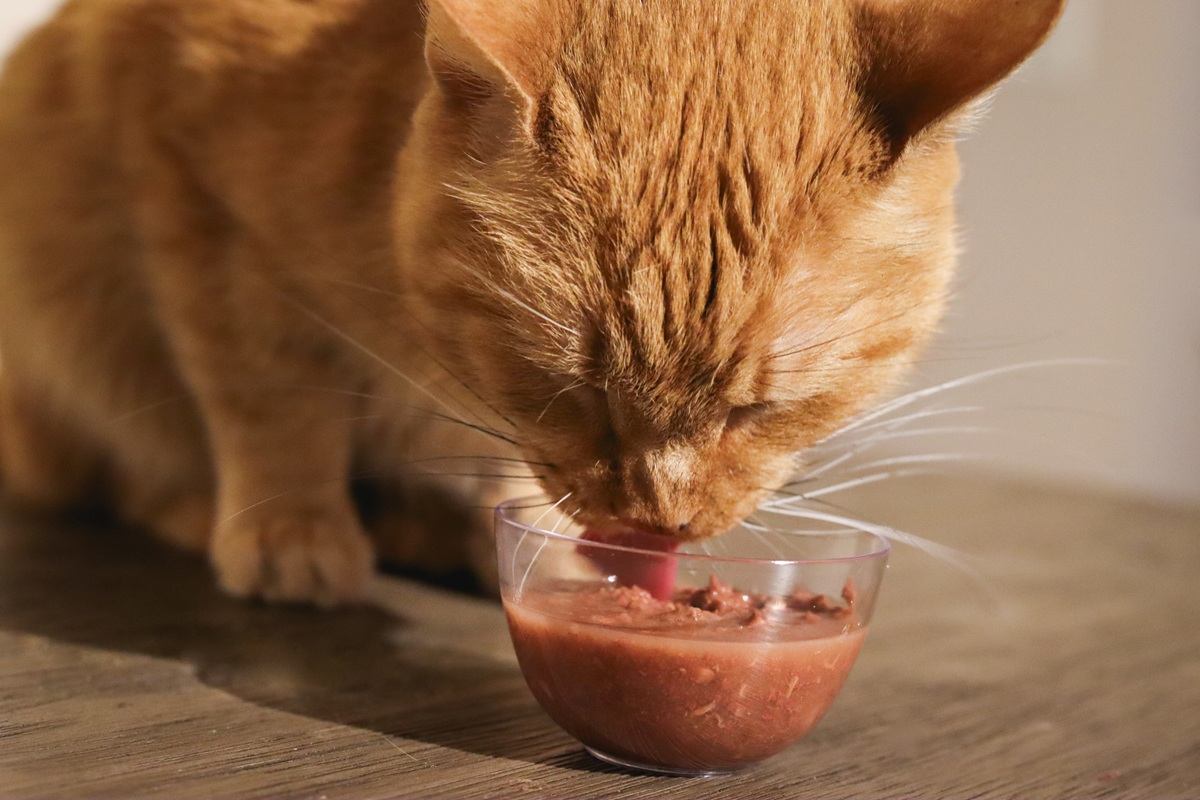
Kirsten McCarthy / Cats.com
Foods that are particularly rich in specific nutrients or beneficial compounds have come to be known as superfoods. From green tea and garlic to cranberries and kale, the list of human superfoods seems endless. But what are superfoods for cats? Do they even exist?
The answer is yes, certain foods have the potential to boost your cat’s nutrition and may even contribute to specific health benefits. However, they might not be the superfoods you’re familiar with. In this guide, we explore the top superfoods for cats and discuss how to safely include them in your cat’s dietary routine.
Do Cats Need Superfoods?
Your cat’s nutritional needs are very different from your own. A green salad topped with fresh blueberries and grilled salmon is a super-healthy human meal but your cat might do better with the salmon alone. That’s because cats are obligate carnivores—they are designed to process and derive nutrition more efficiently from animal products than from plants.
To put it simply, the general definition of superfood can still be applied to a feline diet but the foods that make your cat’s list may differ significantly from your own. And whether superfoods are necessary for cats is a matter that’s up for debate.
Dr. Emma Passman, DVM, says, “Commercial cat foods are created to remove the need for any additions. However, I don’t think it is harmful to add either food ingredients or other types of supplements.” In other words, superfoods aren’t strictly necessary for cats but, the right foods—when offered appropriately—could be beneficial. The key is to choose foods that work with your cat’s biology and to offer them as a supplement or treat—making up no more than 10% of your cat’s daily caloric intake.
Dr. Passman also recommends introducing new foods slowly to avoid upsetting your cat’s digestion. “Actual quantities will vary from cat to cat,” she says. “Watch the cat’s weight and if they tend to be on the heavy side or are elderly, house cats, or generally inactive, adjust their daily meals accordingly.”
The Top 7 Superfoods for Cats
You can probably name half a dozen (or more) human superfoods off the top of your head. They’re fresh fruits bursting with antioxidants, lean meats packed with protein, and even beverages that provide nutritional benefits beyond simple hydration. But not all the foods that are super nutritious for people are appropriate for our pets.
The best superfoods for cats are foods that complement their carnivorous biology. The following foods are not only nutritious for cats, but they’re easily digestible and biologically appropriate. When offering novel foods, it’s important to try them in small quantities first, so that your cat’s digestive system is not overwhelmed.
1. Pumpkin
Here’s one you’re probably familiar with, as it’s a well-known superfood for humans. Nutritionally speaking, pumpkin is rich in potassium, magnesium, and vitamins A, E, and C. What makes it a superfood for cats, however, is its potential use as a digestive aid. Cats will only require a small amount of pumpkin, as the majority of their diet should be based on animal products.
Pumpkin is a good source of soluble fiber. While insoluble fiber remains solid as it passes through the digestive system, soluble fiber absorbs water as it goes. The soluble fiber in pumpkin—particularly in an easily digestible form like plain pumpkin puree—may help firm up loose stools or relieve diarrhea.
While 60% of the dietary fiber in pumpkin is soluble, the remaining 40% is insoluble. For cats with constipation, insoluble fiber may help food (and even hairballs) pass more smoothly through the digestive tract. The fiber in pumpkin may also provide prebiotic benefits, helping promote a healthy balance of beneficial bacteria that supports gut health.
2. Small, Oily Fish

Small oily fish are an excellent source of omega-3 fatty acids. Pogodina Natalia / Shutterstock
Due to the risk for mercury poisoning, many veterinarians caution against feeding an entirely fish-based diet. As a supplement, however, fish can be a great source of omega-3 fatty acids which provide numerous health benefits for our feline friends.
Small, oily fish like sardines and anchovies are particularly high in omega-3s. They also tend to have the lowest mercury content. Omega-3 fatty acids offer anti-inflammatory benefits which can be helpful for cats with arthritis or other joint issues. These healthy fats also support skin and coat health, particularly for cats suffering from dry skin, allergies, or skin problems.
Hint: I like to use sardines to disguise my cats’ pills because the strong aroma masks the scent of the medication. Just be sure to buy sardines packed in water, not oil, to minimize the caloric impact.
3. Lean Meats
Meat is the foundation of a healthy diet for cats, and lean meats make for nutritious treats and meal toppers. Unlike protein-rich plant foods like grains and legumes, meat is considered a complete protein for cats—it contains all the essential amino acids your cat’s body can’t synthesize from other nutrients, like taurine.
Small pieces of cooked, lean meat like chicken, turkey, or pork can be offered as low-calorie treats or as a protein supplement to your cat’s diet. If you’re adventurous enough to try your hand at positive reinforcement training, something meaty makes for a great high-value reward to keep your cat motivated.
4. Organ Meats
Though they may not sound appetizing to you, organ meats are a significant component of a wild feline diet. They’re packed with key vitamins and minerals, often in higher concentrations than muscle meat. Organ meats are particularly rich in iron, zinc, and selenium and B-vitamins like riboflavin, folate and vitamin B12.
The key to offering organ meats is to do so in moderation. Organ meats are very rich and can also be high in calories. If overfed, they can throw off the micronutrient balance of your cat’s diet. Some easy-feed options include freeze-dried chicken hearts or cooked beef liver. You can even buy chicken liver powder as a nutritional supplement, though it’s best to check with your veterinarian before offering it.
5. Barley Grass

Eating grass is a common pastime for some cats. Szymon Mucha / Shutterstock.com
Some cats absolutely love to chew on grass and, if yours falls into this category, maybe it’s time to embrace the habit. While your front yard might not be the safest place for your cat to graze—especially if you treat your lawn with fertilizer or herbicide—you can easily grow cat-safe grass in a container garden or right in your kitchen.
A number of different grasses are considered safe and nutritious for cats, including wheatgrass, oat grass, and barley grass. Cat grass is a great source of fiber and chewing on it can also provide your cat with enrichment and mental stimulation. You can find sprouted grass at your local pet store, pick up seeds from a local nursery, or buy an at-home growing kit.
6. Eggs
Like meat, eggs are a source of complete protein for cats and, because they’re animal-based, they’re easily digestible. Aside from plenty of protein, eggs contain omega-3 fatty acids, B vitamins, and other vitamins like A, D, and E. The shells are commonly used as a source of calcium in homemade cat food recipes.
Raw eggs are a natural component of a wild feline diet but it’s generally best to cook any eggs you plan on offering your cat. If you’re concerned about calories, stick to unseasoned egg whites sauteed in a little neutral cooking oil.
If you really want your cat to live their best life, eggs are a superfood you can get creative with. Freeze-dried or fresh cooked quail eggs make for a special (and nutritious) treat. If you can’t find them at your local health food store, consider ordering from a raw pet food company like Savage Cat.
7. Raw Bones

Soft, raw meaty bones like turkey necks or chicken feet can support dental health and help relieve stress through natural chewing behavior. Butus Shutterstock.com
There’s plenty of debate surrounding the safety of homemade and commercial raw diets for cats. Regardless of what you feed your cat, however, raw bones could be a nutritious dietary supplement. While muscle meat is packed with protein and organ meats are rich in vitamins, raw bones are a key source of minerals in a wild feline diet.
Raw meaty bones that are soft enough for your cat to thoroughly chew—like turkey necks or chicken feet—can even provide dental benefits, helping to scrape plaque from the surface of your cat’s teeth. Chewing can also be a stress-relieving activity for anxiety-prone cats.
Safety is key when offering raw bones as a superfood for your cat. Cooked bones can splinter, posing a choking hazard, and poorly digested bones can put your cat at risk for bowel impaction. Talk to your veterinarian before offering your cat raw bones and only offer those which are appropriate for their age, size and health. High levels of certain dietary minerals (like phosphorus) may not be appropriate for cats with certain health concerns, like chronic kidney disease.
Frequently Asked Questions
What are super foods for cats?
Superfoods for cats are foods that provide nutritional or health benefits but are also biologically appropriate for a carnivorous diet. While cats have some ability to digest and absorb nutrients from plants, animal-sourced superfoods are going to be easier to digest which increases absorption and utilization of nutrients.
What is the healthiest thing to feed a cat?
The healthiest thing to feed your cat is a diet that meets all your cat’s core requirements for energy and essential nutrients. In most cases, a nutritionally complete commercial cat food formula is the simplest and most effective option.
What can I add to cat food to make it healthier?
While 90% of your cat’s daily calorie intake should come from a nutritionally complete cat food, you can supplement their diet with superfoods like those listed above. Cat food toppers can also be a beneficial addition, boosting the protein, moisture, or calorie content of your cat’s diet. Some toppers and supplements may even help address specific nutritional or health concerns.

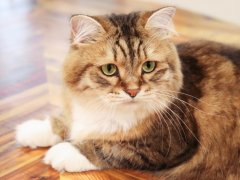

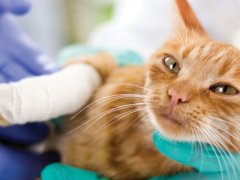
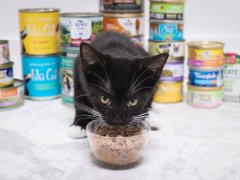
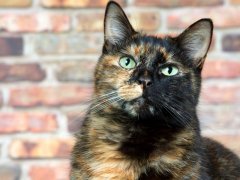

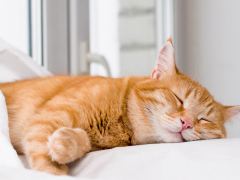
When I went on vacation I had a cat sitter come in and take care of my cat. I had always given a combination of wet and dry food but thought it easier for the cat sitter to just give dry food. Well my cat blocked on this all dry diet. Luckily my cat sitter got him to the vet on time. I don’t think cats should have an all dry diet for this reason. I now give my cat mostly wet food, even human organic chicken, beef, and little dry food. I wouldn’t recommend all dry food.